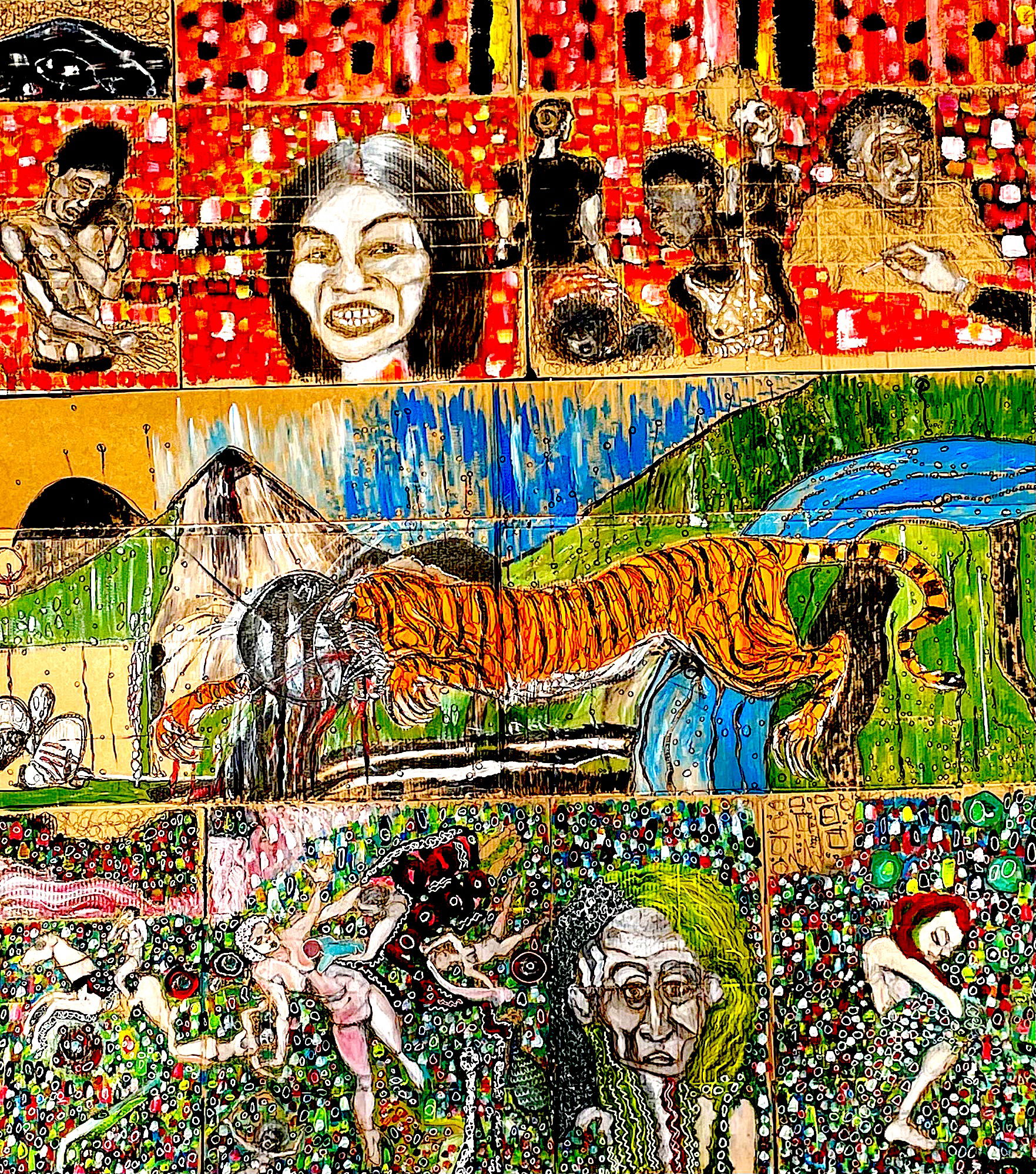On Interpretation 2


14. Dualist philosophers operate with two different levels: with an under-lying text level and an interpretation level lying above. These levels must not be mixed up, so that referring can succeed and validation claims can be redeemed. But a continuous distinction between these two levels is not easy because the occupancy of these levels is often changing: Interpretations that are judged/interpreted can mutate/turn into texts and change from the interpretation level to the text level.
In our example of a Kant seminar the interpretation of the student serves as a text for the interpreting professor and therefore belongs insofar to the text level. For the student however his interpretation of the Kant text remains on the interpretation level. A stabilizing or even intersubjectively binding assignment of language units to text and interpretation and the respective levels is very difficult.
15. The dualist mode of interpretation presupposes the possibility and realizability of a dichotomic distinction between text and interpretation. If we cannot make a reliable distinction between text and interpretation then it will be difficult in conflict situations to put forward or even put through validity claims of & on interpretations with reference to the text. But perhaps the possibility of such a dichotomic distinction is only an allegation, is only wishful thinking?
16. How can we distinguish between text and interpretation in a text-interpretation situation?
This is not simple at all: during an interpretation we cannot distinguish between the text we interpret and our interpreting the text. But how about after the interpretation of the text? Can we distinguish between text and interpretation after the interpretation of the text? Yes, we can: but only within an interpretation of [text and interpretation] - and in this way we are again within an interpretative situation. In this interpretative situation we do not distinguish between [text and interpretation] and interpretation. And as long as we interpret we are always in a situation of being “during” an interpretation. A distinction between text and interpretation is only possible within a further interpretation and this distinction therefore does not bring epistemologically an improvement for a dualist mode of interpretation.
(Of course we can distinguish without problem between the Critique of Pure Reason which lies in green wrappers with traces of use on the desk and a computer printout of the interpretation -- but in this way we do not distinguish between text and interpretation, only between a book on the desk and a computer printout.)
17. Each distinction is preceded by a non-distinction. Distinctions are based on non-distinctions.
18. Distinctions between text and interpretation succeed when we distinguish between text and interpretations of others , for example the interpretations of students. This distinction/difference becomes relevant, when the text is empowered for judgments via the own interpretation.
Text and own interpretation precede the interpretation of the student that is to be judged. Our own interpretation normally remains tacit -- otherwise the student is deprived of the chance for a better, autonomous interpretation from the beginning. We judge the interpretation of the student, amongst other things, on its bringing to the surface contents or intentions, that we already know. Students are often judged on whether they know what the professor already knows. And this implies that we don’t tell the students from the beginning everything we know: Our foreknowledge/advance-knowledge determines the judgment of the students’ interpretations. And we would give away this basis for judgment, once we share it with the students.
19. The dualist and the non-dualist mode of interpretation also differ with respect to the range of the validity claims, that are raised by the interpreters.
In the dualist mode the validity claims onto truth, correctness, consistency and agreement for one’s own interpretations reach beyond them and are interpretation-transcendent. Interpretations can conflict, because they are directed towards the same text and their validity claims overlap.
In the non-dualist mode validity claims are limited/restricted to the interpretations. The interpretations do not raise claims which go beyond them and do not contest with competing interpretations for their place in discourse. They do not assert that some interpretations (namely our own ones) are more correct and more true with reference to the text than others. Perhaps they claim to be more stable, more appropriate, more convincing than other interpretations - but these claims are argumentation-immanent.
20. A significant difference between the dualist and the non-dualist mode lies in the direction of the interpretations .
In the dualist mode interpretations are directed/oriented towards the text and therewith to an instance “lying below” but “ranking above” the text, which determines if interpretations correspond to the text, if they do justice to the text, if they are right or wrong. Only with the help of an interpretation can this instance get differentiated to an extent that it gets decisive power in case of conflict. But for such a differentiation any interpretation can be used that is held and argued for by a proponent, and therefore competing interpretations will turn into stalemate situations. These stalemate/standoff situations can only be dissolved by using/applying interpretative power or the authority of interpretation.
Dualist interpretations are directed/oriented backwards , whereby later interpretations refer to earlier ones and these to a preceding text, which they should agree with. But to fulfil this task is no great deal, as this agreement/correspondence can be had for every interpretation - and just as well against other interpretations, if they are excluded from the text with the help of our own interpretations.
21. In the non-dualist mode interpretations start from the text.
The text is itself an interpretation of another text. Interpretations are interpretations of interpretations, whereby the previous interpretations are incorporated into the following interpretations. This is not a purely accumulative way of proceeding: An interpretation from now on changes the text, the interpretation so far , into a new text, which can be interpreted further in an open process. Here the goal is not, like in the dualist mode, to reduce a plurality of interpretations in direction of the one and true interpretation. The goal is not an interpretation which conforms better with the text, which grasps or matches it better than other interpretations. The goal is, if at all, the change of the interpretative status quo into new, further-leading interpretations und not their conservation or even fundamentalization.
The hope that the better interpretations will survive is only the hope that our own interpretations will survive. And the idea that the true or correct interpretations are going to survive is nothing but the wishful thinking that at least “in the long run” our own interpretations are the winners and not those of our competitors.
22. The idea of a “better”, “correct” or even “true” interpretation is little more than the idea of the most recent/last preferred interpretation. When I work on the interpretation of a text, then my thoughts will often return to the text, from which they start. But this interplay is only a back and forth consideration whether what I say is consistent, whether it fits or not: and these back and forth considerations are the interpretations between which I oscillate/fluctuate and have to make up my mind. And when I finally decide for one interpretation, this could have to do with lots of things: with shortage of time, lack of better ideas, or simply because I want to hold a consistent/coherent line of thought and do not want to allow contradictions. At one point it’s time to stop and the interpretation held last is the one I stick to until others may come.
23. How big are the differences between the two modes of interpretation? This depends on whether the differences are determined by proponents/supporters of the dualist or of the non-dualist mode of interpretation.
For a dualist, the differences are huge. His mode relies on the presupposition that interpretations are directed towards the text: therefore there is a chance to realize the idea of a better, of a correct or even true interpretation in the case of conflicting interpretations. The dualist draws a grim non-dualist scenario: the mix-up or even the denial of the different levels of an interpretation-discourse will lead into an anchorless, anarchist “anything goes” and into extreme forms of relativism. Whether a student’s interpretation of Kant is correct or whether it is a misinterpretation, this would then not depend on the text, but solely on the judgment of the professor, regardless of whether this judgment is purely arbitrary or based on facts. Everybody could claim anything and our thinking would get disorientated and lose all direction. The wildest growth of interpretations could not be cut down via reference to the text; contradictions would flourish and the doors would be wide open to all kinds of arbitrariness.
24. A non-dualist will put the differences much smaller. The differences between the dualist and the non-dualist mode of interpretation are differences between different argumentation techniques and the vocabulary they use.
As long as there are no competing interpretations, the non-dualist finds the conceptual framework of the dualist rather strange and unnecessarily complex.But this framework is the result of a differentiation through the cognitive efforts of many generations of philosophers. The branching out into different schools has the consequence that principal questions are hardly asked any more.
The dualist array of concepts and the associated levels are only activated when conflicts arise between interpretations and between judgments of interpretations. The dualization of the interpretation situation allows to show any arbitrary interpretation as true-correct-adequate, as long as - and this is the only restriction – it is compatible with the own interpretation. The own interpretation gets immunized against criticism because it can secure via the mutually related levels of text and interpretation the necessary correspondences/equivalents in a “beyond of interpretation”.
The non-dualist mode does not work with levels and references, nor with depersonalizations, pre-suppositions/suppositions in advance, nor with equivalents or correspondences. When non-dualists favour one interpretation over another it is a matter of preference and not a matter of reference.
25. The decision between a non-dualist preference mode of interpretation and a dualist reference mode is a decision for a certain technique of argumentation and the conceptual vocabulary connected with it.
So far, the philosophical education has propagated almost exclusively the dualist mode and has tried to establish it as a conditio sine qua non of rational discourse - and thereby preclude it from this discourse.
The non-dualist alternative makes this mode optional , we can opt for it, but also against it.
The End

Josef Mitterer is an Austrian philosopher.
On Interpretation 1 here
The Beyond of Philosophy
The Beyond of Philosophy 1 here
The Beyond of Philosophy 2 here
The Beyond of Philosophy 3 here
The Beyond of Philosophy 4 here
The Beyond of Philosophy 5 here
The Beyond of Philosophy 6 here
The Beyond of Philosophy 7 here
The Beyond of Philosophy 8 here
The Beyond of Philosophy 9 here
The Beyond of Philosophy 10 here